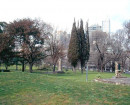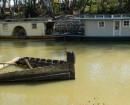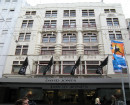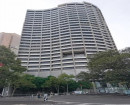Back to search results
MOUNT LITTLE DICK FIRE TOWER
MOUNT LITTLE DICK ROAD DEPTFORD, EAST GIPPSLAND SHIRE
MOUNT LITTLE DICK FIRE TOWER
MOUNT LITTLE DICK ROAD DEPTFORD, EAST GIPPSLAND SHIRE
All information on this page is maintained by Heritage Victoria.
Click below for their website and contact details.
Victorian Heritage Register
-
Add to tour
You must log in to do that.
-
Share
-
Shortlist place
You must log in to do that.
- Download report

2025 Heritage Victoria










On this page:
Statement of Significance
The Mount Little Dick Fire Tower is on the land of the Gunaikurnai people. It is located on Crown land subject to both a Native Title determination and a Recognition and Settlement Agreement under the Traditional Owner Settlement Act.
What is significant?
The Mount Little Dick Fire Tower is a timber fire spotting tower located on the summit of Mount Little Dick in the Bruthen State Forest. It was erected in 1940 by the Forests Commission of Victoria following the devastating Black Friday bushfires of 1939.
How is it significant?
The Mount Little Dick Fire Tower is of historical significance to the State of Victoria. It satisfies the following criterion for inclusion in the Victorian Heritage Register:
Criterion A
Importance to the course, or pattern, of Victoria’s cultural history.
Criterion B
Possession of uncommon, rare or endangered aspects of Victoria’s cultural history.
Criterion D
Importance in demonstrating the principal characteristics of a class of cultural places and objects.
Criterion A
Importance to the course, or pattern, of Victoria’s cultural history.
Criterion B
Possession of uncommon, rare or endangered aspects of Victoria’s cultural history.
Criterion D
Importance in demonstrating the principal characteristics of a class of cultural places and objects.
Why is it significant?
The Mount Little Dick Fire Tower is historically significant as an evocative remnant of the responses to Victoria’s devastating Black Friday bushfires of January 1939. Following the fires, the Forests Commission embarked on a state-wide effort to improve fire detection measures, including the expansion of its network of fire detection towers. The Mount Little Dick Fire Tower is an outcome of that era and enables the impact of the 1939 bushfires to be well understood.
(Criterion A)
The Mount Little Dick Fire Tower is significant as a rare surviving example of a timber fire tower. Its four-legged design was a once common type in Victoria, yet few comparable examples survive. Many have since been destroyed by fire, while other examples have been demolished and replaced with other structures. The Mount Little Dick Fire Tower is the most intact remaining example of its type in Victoria and is now a relatively early surviving example.
(Criterion B)
The Mount Little Dick Fire Tower is significant as a notable example of a timber fire tower in Victoria. Dating from the immediate aftermath of the 1939 bushfires, it is a particularly historically relevant example. It retains many of its original elements, including its timber cabin and a portion of the ladder, enabling the design and construction of these structures to be well understood. Its construction from readily available local timber demonstrates the skill and ingenuity of its builders.
(Criterion D)
Show more
Show less
-
-
MOUNT LITTLE DICK FIRE TOWER - History
Black Friday 1939
In December 1938, bushfires began in several locations across Victoria after a number of years of drought and an unusually hot summer. By early January 1939, fires were burning in places as widespread as the Otway Ranges, Bairnsdale, Woodend, Penshurst, Dromana and Warburton. Logging and timber milling settlements, often situated in remote locations throughout Victoria’s forests, were particularly vulnerable. On 13 January 1939, temperatures were over 40 degrees Celsius in much of Victoria, accompanied by high winds. The conditions intensified existing fires and sparked new fires. Enormous fire fronts spread through large areas of north-east and south-west Victoria. The 13 January 1939 represented the most devastating day of bushfires experienced in Victoria since 1851 and became known as Black Friday.
From December 1938 to January 1939, up to 2 million hectares were burned, much of it mature forest. Seventy-one people were killed, and more than 650 buildings were destroyed. The townships of Narbethong, Noojee, Woods Point, Nayook West and Hill End were lost while Warrandyte, Yarra Glen, Omeo and Pomonal were severely damaged. The fires were a significant event in Victoria’s environmental history, their intensity destroying thousands of hectares of forest and affecting soil quality and water catchments for several decades. The severity of the bushfires changed public and government attitudes towards the prevention, detection and fighting of bushfires and led to multiple reforms.
Stretton Royal Commission
Three weeks after the fires, Judge Leonard Stretton led a Royal Commission into the causes of the January 1939 fires. Stretton heard hundreds of witnesses across 34 days of hearings. His report contained numerous findings about the factors that had contributed to the fires. The Forests Commission – a government agency established in 1918 to oversee State forests, including their use for logging and milling – was identified for criticism, with Stretton writing ‘it must be stated as an objective fact that Forests Commission has failed in its policy of fire prevention and suppression.’ The report also made numerous recommendations to mitigate the risk of future bushfires. Specifically, Stretton recommended improved early detection of fires via air and ground patrols and fire spotting towers. He wrote that ‘towers so placed that no part of the forest is beyond range of the vision of observers, should be placed throughout the forest’. Although the Forests Commission and other government agencies had utilised towers and locations such as hilltops to spot fires since at least the 1920s, Stretton’s recommendations led to an expansion and improvement of the fire detection network.Mount Little Dick Fire Tower
There appears to have been a fire tower on the summit of Mount Little Dick from around 1930 (not the existing tower). Following the 1939 fires and Stretton’s report, the Forests Commission rapidly expanded and upgraded its fire detection system. The Forests Commission’s Annual Report for 1939-40 stated that ‘the detection system is being considerably strengthened by the construction of a series of new towers and lookouts’. By 1945, the Forests Commission operated over 100 fire lookouts and fire towers across Victoria. In the Bruthen District, this era saw the construction of three timber fire towers. Mount Little Dick (the current tower) was constructed in 1940, while Mount Taylor (no longer extant) and Mount Sugarloaf (no longer extant) followed in 1941 and 1948 respectively. The Mount Little Dick Fire Tower was built by two well-known Forest Commission employees – Cecil Cross and Charlie Wain. All the timber for the tower was obtained and squared with hand-tools on site. Each side of the tower was likely constructed on the ground and raised with ropes and pulleys. Its construction from immediately accessible materials with basic equipment demonstrates a high degree of skill and ingenuity. Although its condition was assessed as being good in an engineer’s report in 1987, it appears to have been abandoned in the mid-1990s.
Forest Fire Management Victoria still operates approximately 72 fire towers across Victoria, most of them steel and constructed since the 1980s. Given their locations, age and construction materials, timber fire towers are particularly vulnerable to destruction during bushfires. Several key examples have been lost to fire in recent years, including the Stringers Knob Fire Spotting Tower (VHR H2244) in the Black Summer fires of 2019-20.
Selected bibliography
Primary sources
Forests Commission of Victoria, Annual Report 1939-40.
Stretton, Leonard E. B., Report of the Royal Commission to inquire into the causes of and measures taken to prevent the bush fires of January, 1939 and to protect life and property and the measures to be taken to prevent bush fires in Victoria and to protect life and property in the event of future bush fires, 1939.
Websites
‘Black Friday 1939’, Forest Fire Management Victoria, .
‘Bushfire history’, Department of Environment and Primary Industries, .
‘Fire Lookouts Downunder’, .
‘Victoria’s Forests & Bushfire Heritage’, .
Books and other publications
Collins, Paul., Burn: The Epic Story of Bushfire in Australia, Brunswick, Victoria: Scribe Publications, 2009.
McHugh, Peter., ‘Fire lookouts and towers’, reproduced on .
Noble, W.S.; Ordeal by Fire: The Week a State Burned up, Melbourne: Hawthorn Press, 1977.
Interviews and consultation
The Executive Director thanks the following people for sharing their knowledge of the Mount Little Dick Fire Tower:
• Peter McHugh, author and retired forester and firefighter
• Andrew Martin, DEECA
• Andre Belterman, Australian fire tower researcher.
MOUNT LITTLE DICK FIRE TOWER - Permit Exemptions
General Exemptions:General exemptions apply to all places and objects included in the Victorian Heritage Register (VHR). General exemptions have been designed to allow everyday activities, maintenance and changes to your property, which don’t harm its cultural heritage significance, to proceed without the need to obtain approvals under the Heritage Act 2017.Places of worship: In some circumstances, you can alter a place of worship to accommodate religious practices without a permit, but you must notify the Executive Director of Heritage Victoria before you start the works or activities at least 20 business days before the works or activities are to commence.Subdivision/consolidation: Permit exemptions exist for some subdivisions and consolidations. If the subdivision or consolidation is in accordance with a planning permit granted under Part 4 of the Planning and Environment Act 1987 and the application for the planning permit was referred to the Executive Director of Heritage Victoria as a determining referral authority, a permit is not required.Specific exemptions may also apply to your registered place or object. If applicable, these are listed below. Specific exemptions are tailored to the conservation and management needs of an individual registered place or object and set out works and activities that are exempt from the requirements of a permit. Specific exemptions prevail if they conflict with general exemptions. Find out more about heritage permit exemptions here.Specific Exemptions:The works and activities listed below under the heading ‘Exempt works and activities’ are not considered to cause harm to the cultural heritage significance of the Mount Little Dick Fire Tower. These are subject to the following guidelines and conditions:
Guidelines for specific permit exemptions
1. Where there is an inconsistency between permit exemptions specific to the registered place or object (‘specific exemptions’) established in accordance with either section 49(3) or section 92(3) of the Act and general exemptions established in accordance with section 92(1) of the Act specific exemptions will prevail to the extent of any inconsistency.
2. In specific exemptions, words have the same meaning as in the Act, unless otherwise indicated. Where there is an inconsistency between specific exemptions and the Act, the Act will prevail to the extent of any inconsistency.
3. Nothing in specific exemptions obviates the responsibility of a proponent to obtain the consent of the owner of the registered place or object, or if the registered place or object is situated on Crown Land the land manager as defined in the Crown Land (Reserves) Act 1978, prior to undertaking works or activities in accordance with specific exemptions.
4. If a Cultural Heritage Management Plan in accordance with the Aboriginal Heritage Act 2006 is required for works covered by specific exemptions, specific exemptions will apply only if the Cultural Heritage Management Plan has been approved prior to works or activities commencing. Where there is an inconsistency between specific exemptions and a Cultural Heritage Management Plan for the relevant works and activities, Heritage Victoria must be contacted for advice on the appropriate approval pathway.
5. Specific exemptions do not constitute approvals, authorisations or exemptions under any other legislation, Local Government, State Government or Commonwealth Government requirements, including but not limited to the Planning and Environment Act 1987, the Aboriginal Heritage Act 2006, and the Environment Protection and Biodiversity Conservation Act 1999 (Cth). Nothing in this declaration exempts owners or their agents from the responsibility to obtain relevant planning, building or environmental approvals from the responsible authority where applicable.
6. Care should be taken when working with heritage buildings and objects, as historic fabric may contain dangerous and poisonous materials (for example lead paint and asbestos). Appropriate personal protective equipment should be worn at all times. If you are unsure, seek advice from a qualified heritage architect, heritage consultant or local Council heritage advisor.
7. The presence of unsafe materials (for example asbestos, lead paint etc) at a registered place or object does not automatically exempt remedial works or activities in accordance with this category. Approvals under Part 5 of the Act must be obtained to undertake works or activities that are not expressly exempted by the below specific exemptions.
8. All works should be informed by a Conservation Management Plan prepared for the place or object. The Executive Director is not bound by any Conservation Management Plan and permits still must be obtained for works suggested in any Conservation Management Plan.
General conditions for specific permit exemptions1. All works or activities permitted under specific exemptions must be planned and carried out in a manner which prevents harm to the registered place or object.?Harm includes moving, removing or damaging any part of the registered place or object that contributes to its cultural heritage significance.
2. If during the carrying out of works or activities in accordance with specific exemptions original or previously hidden or inaccessible details of the registered place are revealed relating to its cultural heritage significance, including but not limited to historical archaeological remains, such as features, deposits or artefacts, then works must cease and Heritage Victoria notified as soon as possible.
3. If during the carrying out of works or activities in accordance with specific exemptions any Aboriginal cultural heritage is discovered or exposed at any time, all works must cease and the Secretary (as defined in the Aboriginal Heritage Act 2006) must be contacted immediately to ascertain requirements under the Aboriginal Heritage Act 2006.
4. If during the carrying out of works or activities in accordance with specific exemptions any munitions or other potentially explosive artefacts are discovered, Victoria Police is to be immediately alerted and the site is to be immediately cleared of all personnel.
5. If during the carrying out of works or activities in accordance with specific exemptions any suspected human remains are found the works or activities must cease. The remains must be left in place and protected from harm or damage. Victoria Police and the State Coroner’s Office must be notified immediately. If there are reasonable grounds to believe that the remains are Aboriginal, the State Emergency Control Centre must be immediately notified on 1300 888 544, and, as required under s.17(3)(b) of the Aboriginal Heritage Act 2006, all details about the location and nature of the human remains must be provided to the Aboriginal Heritage Council (as defined in the Aboriginal Heritage Act 2006).
Fire Tower
1. Repairs and maintenance to the fire tower and cabin, including the localised replacement of original fabric with new fabric provided:
- the original appearance of the fire tower is not permanently altered
- the retention of original physical fabric is maximised
- new fabric is only introduced if original fabric is missing or deteriorated to the point it cannot be repaired
- new timbers are eucalypt species with similar qualities to the original
- techniques utilised in carrying out repairs reflect the original as much as practicable.
2. All works and activities necessary to protect the fire tower if it is under threat during a bushfire or other emergency, such as the application of fire retardant.
3. Works essential for emergency stabilisation of the fire tower, provided Heritage Victoria is informed within seven days of the works being carried out.
4. Application of termite controls and treatments.
Landscape and surrounds
5. Repairs, maintenance, removal and replacement of existing perimeter fence, provided replacement is of the same size, location and type as the existing fence.
6. Installation of temporary security fencing, signage, scaffolding, hoardings, lighting and surveillance systems provided they are not attached to the fire tower.
7. Installation of signage authorised by the relevant government agencies, provided it is not attached to the fire tower.
8. Repairs, maintenance, installation and removal of standard park furniture, such as picnic tables.
9. Road and track repairs and maintenance, including grading, resurfacing and the like.
10. Management of vegetation, including removal.
11. Fire suppression and firefighting activities such as fuel reduction burns and fire control line construction, provided protection is in place for the fire tower.
-
-
-
-
-
SWAN HILL WATER TOWER
 Victorian Heritage Register H2452
Victorian Heritage Register H2452 -
RULES OF THE MELBOURNE FOOTBALL CLUB
 Victorian Heritage Register H2428
Victorian Heritage Register H2428 -
NORTH MELBOURNE POTTERY
 Victorian Heritage Inventory
Victorian Heritage Inventory
-
1 Jackson Street
 Yarra City
Yarra City -
1 Lightfoot Street
 Yarra City
Yarra City -
1 Longfield Street
 Yarra City
Yarra City
-
-











